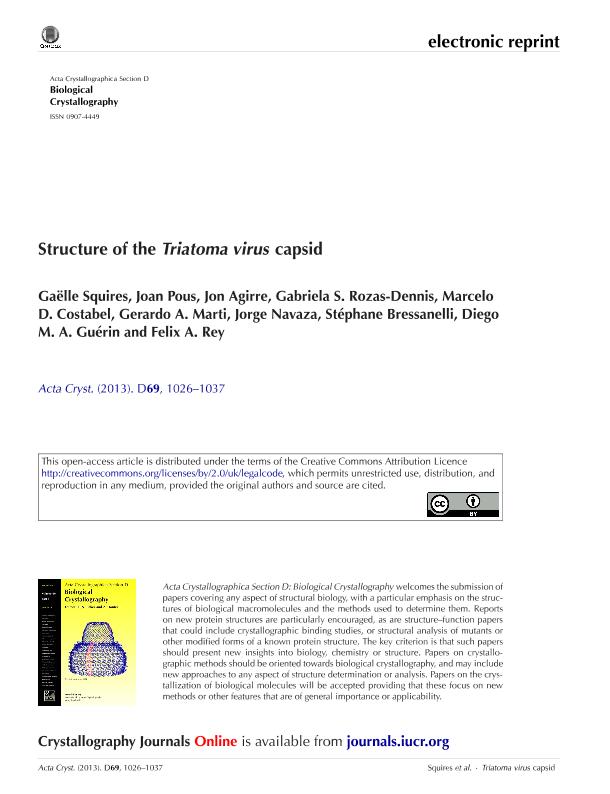Mostrar el registro sencillo del ítem
dc.contributor.author
Squires, Gaëlle
dc.contributor.author
Pous, Joan
dc.contributor.author
Aguirre, Jon
dc.contributor.author
Rozas Dennis, Gabriela Susana

dc.contributor.author
Costabel, Marcelo Daniel

dc.contributor.author
Marti, Gerardo Anibal

dc.contributor.author
Navaza, Jorge
dc.contributor.author
Bressanelli, Stéphane
dc.contributor.author
Guérin, Diego Marcelo Alejandro

dc.contributor.author
Rey, Felix A.
dc.date.available
2020-04-03T17:29:37Z
dc.date.issued
2013-04
dc.identifier.citation
Squires, Gaëlle; Pous, Joan; Aguirre, Jon; Rozas Dennis, Gabriela Susana; Costabel, Marcelo Daniel; et al.; Structure of the Triatoma virus capsid; Wiley Blackwell Publishing, Inc; Acta Crystallographica Section D-Biological Crystallography; 69; 4-2013; 1026-1037
dc.identifier.issn
0907-4449
dc.identifier.uri
http://hdl.handle.net/11336/101866
dc.description.abstract
The members of the Dicistroviridae family are non-enveloped positive-sense single-stranded RNA (+ssRNA) viruses pathogenic to beneficial arthropods as well as insect pests of medical importance. Triatoma virus (TrV), a member of this family, infects several species of triatomine insects (popularly named kissing bugs), which are vectors for human trypanosomiasis, more commonly known as Chagas disease. The potential use of dicistroviruses as biological control agents has drawn considerable attention in the past decade, and several viruses of this family have been identified, with their targets covering honey bees, aphids and field crickets, among others. Here, the crystal structure of the TrV capsid at 2.5 A ˚ resolution is reported, showing that as expected it is very similar to that of Cricket paralysis virus (CrPV). Nevertheless, a number of distinguishing structural features support the introduction of a new genus (Triatovirus; type species TrV) under the Dicistroviridae family. The most striking differences are the absence of icosahedrally ordered VP4 within the infectious particle and the presence of prominent projections that surround the fivefold axis. Furthermore, the structure identifies a second putative autoproteolytic DDF motif in protein VP3, in addition to the conserved one in VP1 which is believed to be responsible for VP0 cleavage during capsid maturation. The potential meaning of these new findings is discussed
dc.format
application/pdf
dc.language.iso
eng
dc.publisher
Wiley Blackwell Publishing, Inc

dc.rights
info:eu-repo/semantics/openAccess
dc.rights.uri
https://creativecommons.org/licenses/by-nc-sa/2.5/ar/
dc.subject
Triatoma virus
dc.subject
Trv
dc.subject
Cripavirus
dc.subject
Dicistroviridae
dc.subject.classification
Física Atómica, Molecular y Química

dc.subject.classification
Ciencias Físicas

dc.subject.classification
CIENCIAS NATURALES Y EXACTAS

dc.title
Structure of the Triatoma virus capsid
dc.type
info:eu-repo/semantics/article
dc.type
info:ar-repo/semantics/artículo
dc.type
info:eu-repo/semantics/publishedVersion
dc.date.updated
2020-04-02T13:54:06Z
dc.journal.volume
69
dc.journal.pagination
1026-1037
dc.journal.pais
Reino Unido

dc.journal.ciudad
Londres
dc.description.fil
Fil: Squires, Gaëlle. Centre National de la Recherche Scientifique; Francia. Laboratoire de Virologie Moléculaire et
Structurale; Francia
dc.description.fil
Fil: Pous, Joan. Centre National de la Recherche Scientifique; Francia. Laboratoire de Virologie Moléculaire et
Structurale; Francia
dc.description.fil
Fil: Aguirre, Jon. Universidad del País Vasco; España. Consejo Superior de Investigaciones Científicas; España. Fundación Biofísica Bizkaia; España
dc.description.fil
Fil: Rozas Dennis, Gabriela Susana. Universidad Nacional del Sur. Departamento de Biología, Bioquímica y Farmacia; Argentina. Consejo Nacional de Investigaciones Científicas y Técnicas. Centro Científico Tecnológico Conicet - La Plata. Centro de Estudios Parasitológicos y de Vectores. Universidad Nacional de La Plata. Facultad de Ciencias Naturales y Museo. Centro de Estudios Parasitológicos y de Vectores; Argentina
dc.description.fil
Fil: Costabel, Marcelo Daniel. Universidad Nacional del Sur. Departamento de Biología, Bioquímica y Farmacia; Argentina
dc.description.fil
Fil: Marti, Gerardo Anibal. Consejo Nacional de Investigaciones Científicas y Técnicas. Centro Científico Tecnológico Conicet - La Plata. Centro de Estudios Parasitológicos y de Vectores. Universidad Nacional de La Plata. Facultad de Ciencias Naturales y Museo. Centro de Estudios Parasitológicos y de Vectores; Argentina
dc.description.fil
Fil: Navaza, Jorge. Laboratoire de Virologie Moléculaire et
Structurale; Francia. Centre National de la Recherche Scientifique; Francia
dc.description.fil
Fil: Bressanelli, Stéphane. Laboratoire de Virologie Moleculaire Et Structurale; Francia. Centre National de la Recherche Scientifique; Francia
dc.description.fil
Fil: Guérin, Diego Marcelo Alejandro. Consejo Nacional de Investigaciones Científicas y Técnicas. Centro Científico Tecnológico Conicet - La Plata. Centro de Estudios Parasitológicos y de Vectores. Universidad Nacional de La Plata. Facultad de Ciencias Naturales y Museo. Centro de Estudios Parasitológicos y de Vectores; Argentina. Fundación Biofísica Bizkaia; España. Consejo Superior de Investigaciones Científicas; España. Universidad del País Vasco; España
dc.description.fil
Fil: Rey, Felix A.. Centre National de la Recherche Scientifique; Francia. Laboratoire de Virologie Moleculaire Et Structurale; Francia
dc.journal.title
Acta Crystallographica Section D-Biological Crystallography

dc.relation.alternativeid
info:eu-repo/semantics/altIdentifier/url/http://scripts.iucr.org/cgi-bin/paper?S0907444913004617
dc.relation.alternativeid
info:eu-repo/semantics/altIdentifier/doi/http://dx.doi.org/10.1107/S0907444913004617
Archivos asociados
